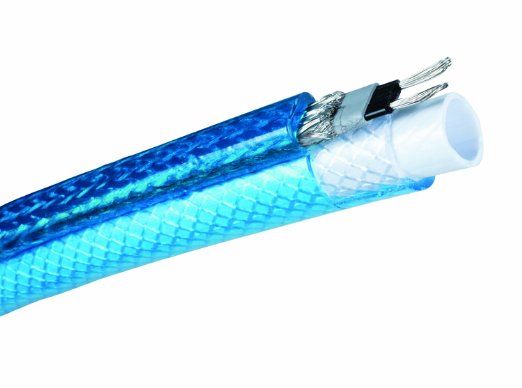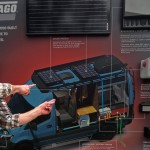This post may contain affiliate links.
We saw this heated hose on display at the RVIA show in Louisville this past December. Since we talk so much about using your RV in the winter, well, we just had to check it out. This product would be most useful for someone who intended to stay in place with full hookups during the winter. The company is Pirit – but they say it “Pirate”! Have a look:
I’ve seen plenty of heated hoses before. But usually, they’re something that looks like a heat tape stuck to a regular hose. Something like this:
The big problem with these kinds of hoses is “buckling” or “bubbling”. Since the hose is really two things stuck together – and those two things are at two different temperatures and they expand and contract at different rates. So the heat tape buckles up on the hose, and splits the casing, or whatever. It’s a very common problem with those types of hoses. If you’re like me, you wouldn’t buy a heated because you want an additional item to baby and take care of so it doesn’t buckle! No, you’d buy a heated hose because you want something to ensure water delivery in freezing temperatures.
That’s why I was excited about the Pirit hose. It doesn’t have this same construction. Instead, the heating elements are inside the material of the hose itself. You can see it in the video. It can’t buckle or delaminate (at least as far as I can tell). And it certainly seems to be quite a bit safer than some of the “home made” solutions I’ve seen. Maybe I’m crazy, but something about water and electricity makes me disinclined to experiment…
Anyway, as I said, this would be an ideal hose for someone who intended to have full hookups for their RV during a winter camping trip. The hose itself is bigger than our usual hose – but if we were going to be in a stay-put situation, we’d find the room for it (but we’d stick with the 25 foot model). They have plenty of dealers, but the easiest way to get them is likely to be on Amazon.com.
I’m kicking around the idea of picking one of these up for some sort of long-term performance (and taste) test. If I do, there’ll certainly be a video…












How did this go from Heated water hose to toilets.??
Huh? You mean the mention of the heated sewage hose?
My dad is planning to drive across country and wants to make sure that the RV is in perfect travel condition. It was explained here that having a heated hose is safer to use the regular hose available at home. Furthermore, it’s ideal to go to trusted suppliers when planning to have a heated hose.
Thanks James!
I am going to call Jeff from AirHead to discuss this with him as he told me the shortest route for the vent hose was best; either through the floor or through the side wall…so now I am a bit confused but we will get it right eventually and hopefully before it is installed!
Sorry for the late reply. My technical advisor brought back an unwelcome stomach virus when he returned from his latest trip.
Shorter is definitely better for venting. You’ll get more air flow that way for sure. I would go underneath before I would go out the side. it will be easier to hide a “360 siphon” or similar.
Well that eases my mind a little bit. I know there will be a learning curve with this. We just need to get it installed correctly so it will work to the best of it’s composting ability!
Stephanie and James,
Thanks for all the helpful information you pass along to your subscribers.
…Still waiting for more helpful user information about The Air Head composting toilet.
Our builder was not happy about the size of it, in fact we had to eliminate a closet to accommodate it in the Promaster.
We are venting it through the floor. He thinks whatever smell there is will find it’s way back up through the coach…any suggestions?
Thanks,
Rande
Well, if it’s sealed properly, I doubt any odors would make their way back inside. BUT you might not want to hang out in a lawn chair outside…
Generally though, once it gets cooking, the odors are pretty tame. Besides for a few minutes after use, if you’ve got odors – you’ve got problems.
Venting is key for these. You will want to make sure you’ve got a way to have negative pressure on the toilet vent at all times – with the wind blowing from any direction, while driving, etc.
Thanks for your reply but “Oh my!”… So, are you saying if we are sitting outside we will smell ‘it’?…and worse; others camping around us may smell ‘it’?
If this doesn’t work (and it’s an expensive experiment) we will have no other option; other than a cassette toilet as we are opting for a larger fresh water tank and a larger grey tank (no black tank).
So, this may be a dumb question but, keep in mind, I am not a rocket scientist and my technical advisor is on a business trip!
By negative pressure do you mean no air blowing into the toilet vent? If so, wouldn’t that be difficult to control? How did you achieve this?
Thanks!,
Rande
If the toilet is working properly, you won’t smell much more than when you use a regular toilet. Briefly, while “in use”, and then no more. But if your toilet has issues, then yes, you would smell it.
Cassette toilets are proven for years over in Europe. More frequent emptying, but other than that, very similar to a US black tank toilet. Don’t be afraid of them.
By negative pressure, I mean that no matter what, air must flowing OUT of the vent (think suction). If, for example, your venting is set up so that air is somehow forced DOWN the vent while driving… that air would be forced up the vent, filtered through the toilet, and then be vented into the coach. Obviously, that’s bad. If you vent to the roof and use a “360 Siphon”, as we do, then you should have no issues.